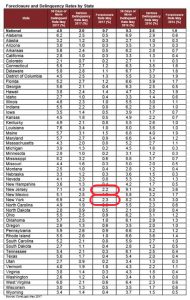From CNBC:
Homebuyers put less and less skin in the game, adding to the market’s overall risk
It feels like deja vu in mortgage land all over again.
Homebuyers are increasingly opting to put less money down when purchasing their homes, increasing their risk should the housing market, and specifically home prices, falter yet again. When home prices crashed in the last decade, millions of borrowers fell underwater on their home loans, prompting a foreclosure crisis of epic proportions. It all begs the question, could it happen again?
In the past 12 months, 1.5 million borrowers bought their homes with down payments of less than 10 percent, meaning they financed more than 90 percent. That marks a seven-year high, according to Black Knight Financial Services.
“The increase is primarily a function of the overall growth in purchase lending, but, after nearly four consecutive years of declines, low down payment loans have ticked upward in market share over the past 18 months as well,” said Ben Graboske, executive vice president at Black Knight Data & Analytics, in a recent note. “In fact, they now account for nearly 40 percent of all purchase lending.”
On the bright side, the bulk of the growth has not been at the lowest down payment level, that is, 3 percent or less. It is more in the 5 to 9 percent down payment arena. In addition, the low down payment loans of today are nothing like the ones the precipitated the last housing crash.
At that time half of all low down payment loans being made involved second loans, commonly known as “piggyback loans,” but today’s mortgages are largely single, first liens, Graboske noted.
The loans of the past were also far riskier – mostly adjustable-rate mortgages, which, according to the Black Knight report, are virtually nonexistent among low down payment mortgages today. Instead, most are fixed rate. Credit scores of borrowers taking out these loans today are also about 50 points higher than those between 2004 and 2007.
The growth in this sector is likely due to new programs offered by Fannie Mae and Freddie Mac that are actually gaining market share from the FHA, which was the only low down payment game in town during the recession. The government-sponsored enterprises brought back 3 percent down payment loans in late 2014, but as with the FHA, they also require borrowers pay for mortgage insurance.

